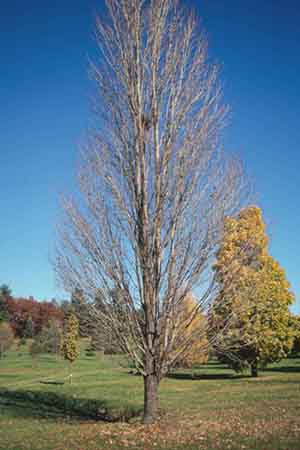Home > Urban/suburban design > Street tree design > Canopy habit and form > Upright
Upright growth form

Many trees along streets, in parking lot islands, and in other high-traffic areas require periodic lower branch removal after planting to allow pedestrians and vehicles to pass safely. This maintenance requirement can be reduced by planting trees with an upright or narrow canopy.
Do not become complacent after planting trees with an upright growth habit. Some develop aggressive upright branches, with weak, included bark in the crotch (see below), if corrective pruning is not done when the tree is young (See: inclusions). This pruning should be directed at preventing development of codominant branches on the lower trunk.
Despite the risk of developing included bark, many upright trees stay together and will not break apart easily, even without pruning. if the life expectancy of the tree at the site is less than 30 years, which is common for many trees planted in urban environments, you may not need to be concerned about trees with included bark.


